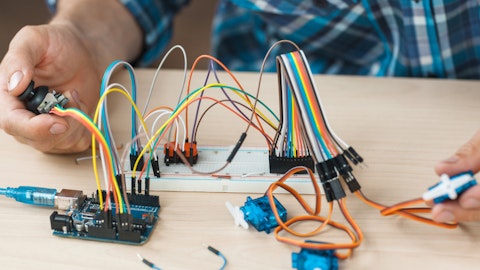Synopsys, Inc. (NASDAQ:SNPS) Q1 2023 Earnings Call Transcript February 15, 2023
Operator: Ladies and gentlemen, welcome to the Synopsys Earnings Conference Call for the First Quarter of Fiscal Year 2023. At this time, all participants are in a listen-only mode. And as a reminder, today’s call is being recorded. At this time, I would like to turn the conference over to Phil Lee, Director of Investor Relations. Please go ahead.
Phil Lee: Good afternoon, everybody. With us today are Aart de Geus, Chair and CEO of Synopsys; and Shelagh Glaser, Chief Financial Officer. Before we begin, I’d like to remind everyone that during the course of this conference call, Synopsys will discuss forecasts, targets and other forward-looking information regarding the company and its financial results. While these statements represent our best current judgment about future results and performance as of today, our actual results are subject to many risks and uncertainties that could cause actual results to differ materially from what we expect. In addition to any risks that we highlight during this call, important risk factors that may affect our future results and performance are described in our most recent filings with the SEC, including our most recent annual report on Form 10-K and subsequently filed quarterly reports on Form 10-Q.
In addition, we will refer to non-GAAP financial measures during the discussion. Reconciliations to certain of these non-GAAP financial measures to their most directly comparable GAAP financial measures a discussion of certain non-GAAP financial measures that we are not able to reconcile without unreasonable efforts and supplemental financial information can be found in the earnings press release financial supplement and 8-K that we released earlier today. All of these items, plus the most recent investor presentation are readily available on our website at www.synopsys.com. In addition, the prepared remarks will be posted on our website at the conclusion of the call. With that, I’ll turn the call over to Aart de Geus.
Aart de Geus: Good afternoon. Q1 delivered a very solid start to the year. Building on our strength and momentum from 2022, we met or exceeded all of our guidance targets. Revenue was $1.36 billion, with non-GAAP operating margin at 35.2%, resulting in GAAP earnings per share of $1.75. And non-GAAP earnings above the high end of our target range at $2.62. Based on the continued robust design activity, we remain confident in our business. We are reaffirming our full year guidance for revenue and non-GAAP op margin improvement while raising guidance for non-GAAP EPS. In the last few years, Synopsys has grown and evolved substantially. Commensurately, we are evolving our financial reporting. Starting in Q1, we are reporting our business in three segments: Design Automation, which includes design software, verification software and hardware and other EDA products.
Design IP, a broad portfolio, including libraries, embedded memories, connectivity solutions, processor cores and security devices. And Software Integrity, which remains unchanged from previous reporting and deliver solutions to improve software quality and security. To give you a relative sense of proportion, Design Automation is about 65% of our revenue. Design IP is approximately 25% and Software Integrity is about 10%. While these numbers are approximate, the 65%, 25%, 10% split is easy to remember and represents well how we think of our present business. We have leadership positions and excellent outlooks in all three segments. As the market leader in design automation, we see continued technical innovation towards still much, much more complex silicon and system designs.
As the company with the broadest portfolio of IP, we see a continuation of designs, needing more communication bandwidth, processing, storage and security in still more advanced silicon technologies. And for our Software Integrity business, we are a key enabler of modern software security with a leading portfolio of products for developers, the DevOps groups and the corporate security teams. Shelagh will discuss the financials in more detail. Looking at the overall market picture, already 12 years ago, we identified the intersection of big data and machine learning as leading us into the age of Smart Everything. Today, smart everything is in full swing. You may have seen the fantastic new capabilities showcased recently by applications such as ChatGPT.
It clearly shows how far Smart Everything has come and also how much further the opportunity space reaches. Indeed, this is playing out as every vertical market is now driving towards more and more sophisticated solutions with an unsatiable need for compute. While some present market undercurrents drive many companies to strive for efficiency, our semiconductor and systems customers continue to prioritize investments in the design of complex chips and software to make all of this possible. Synopsys is in the midst of this quest, and we see our purpose to be a key catalyst enabling the smart everything world. With our customers and partners, our role is to make this all work to the state-of-the-art solutions ranging from the deep physics of silicon to the heights of performance, power and security of complex hardware software systems.
Over the past several years, we have successfully invested in groundbreaking innovations that radically advance how silicon and system design is done. So let me begin with the Design Automation segment, which accounts for about 65% of our revenue and share some highlights around our groundbreaking DSO.ai artificial intelligence design solution. With already well over 100 commercial production designs DSO.ai continues to deliver amazing results for our customers. Applied simultaneously to multiple steps of the design flow, it reduces efforts from months to now weeks while simultaneously delivering higher performance and lower power. Customer adoption continued to accelerate across a wide range of process nodes and market verticals. We already put in production designed by nine of the top 10 semiconductor leaders, customers such as Samsung, Intel, MediaTek, ST Microelectronics and many others are reporting impressive achievements.
In Q1, we saw multiple additional deployments across verticals, including mobile, data center and memory designs. Meanwhile, we have extended our machine learning capabilities to other EDA workloads ranging from verification to test to custom design. These new solutions are already in customer hand showing excellent impact and promise. Critical to the success of DSO.ai are the powerful design engines that sit underneath. The DSO.ai is thus also driving significant cross-selling and accelerated growth across our EDA products. Specifically, our Fusion Compiler momentum is manifested across a wide spectrum of market verticals and manufacturing processes. During the quarter, we achieved multiple advanced node design wins, including a key win at a large hyperscaler and a three-nanometer node design at a leading mobile provider.
Fusion compile is used a 95% of advanced node designs at three-nanometer and below with the majority exclusively using Synopsys flows, stimulated by a wave of high-value innovations customers from high-performance computing to hyperscalers continue to expand their reliance on Synopsys throughout our portfolio. Our custom solutions, for example, saw continued market momentum in Q1 and as we added nine new logos in the quarter with a robust market pipeline. All these highly complex designs need to work both correctly and work under multiple conditions and scenarios like temperature, voltage, manufacturing variability and so on. That’s where our verification tools come in. While verification is fundamentally an unbounded problem, our state-of-the-art simulation, emulation and prototyping products tackle these tough challenges at unparalleled speed with the fastest engines, highest capacity and lowest cost of ownership.
Building on another record year in 2022, we continue to see excellent growth in hardware with both our ZeBu emulation and HAPS prototyping products. This quarter, we achieved major expansions with our Zibo EP1 and HAPS 100 hardware as several of the largest semiconductor systems and hyperscaler companies in the world. Meanwhile, multi-die system design, sometimes also called chiplet-based design is opening a whole new era of silicon complexity. In Q1, our differentiated multi-die solution around 3D IC Compiler continued its strong momentum deployed on production tape-outs at the top, high-performance computing chip supplier and a large networking systems company. Let me move to Design IP, which is, as I mentioned, about 25% of our business.

Third-party IP, think of it as the LEGO blocks of chip design continues to grow in complexity and importance. Our market-leading IP portfolio, by far the broadest in the industry, continues to grow with high demand in high-performance compute, automotive and mobile markets fueled by Smart Everything, multi-die systems and high speed and secure connectivity. While maintaining technical leadership, we’ve broadened our portfolio with new high-speed interfaces in three and four-nanometer processes to serve HPC and mobile applications at the leading edge. In the automotive market, we see strong adoption of automotive-grade IP solutions by OEMs and Tier 1 suppliers now developing their own chips. Meanwhile, multi-die systems require a whole new portfolio of state-of-the-art die-to-die interface IP.
The recently introduced UCIA protocol short for universal chiplet Interconnect Express has become the standard of choice. Synopsys is leading in this area with an industry milestone the tape-out of the first UC IE test chip on a major foundry three-nanometer process node. The increased silicon multichip and high-speed computation push enables enormous advances in the software world. This brings me to our Software Integrity segment, which as mentioned, accounts for about 10% of our revenue. As every vertical market is developing highly complex, big data-driven systems, their requirements for security and safety continue to expand. Our Software Integrity solutions enable organizations to improve and manage the security and quality of software across a wide range of industry verticals from semiconductors and systems to financial services, automotive, industrial, health and more.
While this continues to be one area where we feel some caution from the macro environment, we had a good start to the year with several multiyear, multiproduct transactions and sustained momentum in our indirect channel. We continue to evolve and strengthen our multiproduct platform to help companies gain more comprehensive insight and drive increasingly robust top-down software risk management. Customers who purchased two or more solutions now account for the majority of our Software Integrity revenue as we drive cross-selling opportunities and continue to scale our application security testing platform. In summary, Q1 was a very solid start to the year, delivering strong financial results. We are reiterating our fiscal ’23 revenue growth at 14% to 15% as well as non-GAAP operating margin expansion of more than 100 basis points.
We are raising guidance for fiscal ’23 non-GAAP EPS growth to 18% to 19%. Notwithstanding continued macroeconomic choppiness, our customers continue to prioritize their investments in chips and systems. In addition, our resilient business model provides a level of stability uncommon in most software companies. Meanwhile, our high-impact innovation pipeline across our entire portfolio is driving technical differentiation while solidifying our foundation for continued business growth. With that, I’d like to welcome Shelagh Glaser to our first Synopsys earnings call. We are thrilled to have her on board as a financial, operational and scaling experience as well as a deep understanding of the semiconductor industry are a great asset to Synopsys as we drive exciting growth ambitions.
With that, I’ll turn it over to Shelagh.
Shelagh Glaser: Great. Thank you, Aart, and thank you to the Synopsys team for such a warm welcome. It’s an honor to join a company with a long heritage of innovation and market leadership. I look forward in taking part to drive Synopsys into the next phase of growth in the era of smart everything as well as meeting all of you in the investment community. We delivered a very solid start to the year with revenue above the midpoint of our guided range, non-GAAP operating margin of 35.2% and non-GAAP earnings above the high end of our target range. Our Q1 results were driven by our execution and strong technology portfolio that is expanding customer commitments. Robust chip and system design activity despite lower semiconductor industry revenue growth and a resilient, stable, time-based business model was $6.9 billion in non-cancelable backlog.
We remain confident in our business, and as a result, we are reaffirming our full year 2023 targets for revenue and non-GAAP operating margin improvement and raising our full year outlook for non-GAAP EPS due to a lower tax rate. I’ll now review our first quarter results. All comparisons are year-over-year unless otherwise stated. We generated total revenue of $1.36 billion. Total GAAP costs and expenses were $1.11 billion, which includes approximately $41 million in restructuring costs. Total non-GAAP costs and expenses were $882 million, resulting in non-GAAP operating margin of 35.2%. GAAP earnings per share were $1. 75, non-GAAP earnings per share were $2.62. As Aart mentioned, we are expanding our segment reporting to align with how we’re managing the business.
Starting in Q1, we are now reporting three segments, Design Automation, Design IP and Software Integrity. Design Automation segment revenue was $890 million with both EDA software and hardware performing well. Design Automation adjusted operating margin was 38. 9%. Design IP segment revenue was $344 million, and adjusted operating margin was 34. 2%. Software Integrity revenue was $128 million and adjusted operating margin was 12.1%. We are on track to reach our 15% to 20% revenue growth objective for Software Integrity with increased adjusted operating margin in 2023. Turning to cash. We generated $115 million in operating cash flow. We used $306 million of our cash for stock buybacks. We ended the quarter with cash and short-term investments of $1.3 billion and total debt of $21 million targets.
Now to guidance. For fiscal year 2023, the full year targets are: revenue of $5.775 billion to $5. 825 billion. Total GAAP costs and expenses between $4.54 billion and $4.59 billion. Total non-GAAP costs and expenses between $3.81 billion and $3.84 billion, resulting in non-GAAP operating margin improvement of more than 100 basis points. Non-GAAP tax rate of 16%. GAAP Earnings of $7. 12 to $7.30 per share, non-GAAP earnings of $10.53 to $10.60 per share. Cash flow of operations of approximately $1.65 billion, which includes approximately $40 million to $50 million in restructuring costs. Now to targets for the second quarter. Revenue between $1.36 billion and $1.39 billion, total GAAP costs and expenses between $1.085 billion and $1.105 billion, total non-GAAP costs and expenses between $917 million and $927 million, GAAP earnings of $1.62 to $1.72 per share, and non-GAAP earnings of $2.45 to $2.50 per share.
In conclusion, we delivered a very solid start to the year. While the underlying macroeconomic environment is choppy, we continue to execute and for the year, expect 14% to 15% revenue growth. Non-GAAP operating margin improvement of more than 100 basis points and 18% to 19% non-GAAP EPS growth. Our confidence reflects our innovative technology portfolio, ongoing design activity by our customers who continue to invest through semiconductor cycles and the stability and resiliency of our time-based business model. With that, I’ll turn it over to the operator for questions.
See also Ark Invest Stock Portfolio: 15 Biggest Positions and Ray Dalio Stock Portfolio: Top 15 Stock Picks.
Q&A Session
Follow Synopsys Inc (NASDAQ:SNPS)
Follow Synopsys Inc (NASDAQ:SNPS)
Operator: Thank you. We’ll take our first question from Joe Vruwink with Baird.
Joe Vruwink : Great. Thanks, everyone. Wanted to begin maybe with how the nature of your relationship with customers is changing as they adopt DSO.ai. How does this alter the share of a project wallet you’re able to achieve? And then — how close might we be to this product receiving maybe more of an enterprise-wide buy-in as opposed to project-specific buy-ins. I guess, at the heart of this question, when you next enter the period of big enterprise renewals when we would typically expect your backlog to inflect higher do you think tools like DSO drive a pretty meaningful and visible step-up in total contract values?
Aart de Geus : Well, going backwards on your question, yes, I think it will drive positive growth for Synopsys. And starting at the beginning of your question, which was how does it change the relationship. It’s been actually quite remarkable as we started to travel again this year that after a number of years of being at least physically distant, the relationship with many of our customers have evolved substantially. And I think a big piece of that comes from the fact that they all realize that the technology is becoming way more complex. And actually, in a good way, meaning that both this continuation on the traditional Moore’s Law, but there’s also a whole set of systems interactions be it when you have multiple dies or if you have hardware and software interactions that all demand a degree of automation that is way more sophisticated.
And so in the midst of that, comes the entry now for us a little bit over two years ago of capabilities that really change how design is done. And moreover, it changes them in a very similar fashion like Synthesis literally many decades ago, it automates things that previously were thought to not be automatable. And it does this in a fraction of the time and with better results. And so the engagements have been extremely fast. And the very fact that we can point at so many production designs, we’re not talking people trying stuff out. Many tried it out. And then in the midst of the trial, they said, well, I want to reuse these results because they’re better than what I had before, and that project is not finished yet. And so the adoption is fast.
At the same time, you would say, well, what would slow it down? Well, what slows it down is, are they sure that the tools don’t make mistakes that it’s actually proven technology. And the answer has been a resounding yes. That’s why all these production designs are using it. So I see extremely high opportunity space for us there. And moreover, I think that is touching the tip of the iceberg. Now how that turns into contract evolutions. Well, that’s the negotiation scale that we will need to bring to bear and they will need to bring to bear. But fundamentally, I think we add a lot of value to what they can do. And I think we will be suddenly rewarded in some way from that.
Joe Vruwink : Okay. That’s great. Thanks, Aart. Just in terms of the forecast you’re presenting for the April quarter, how much different is this than maybe what you internally were planning for a quarter ago? I guess, has anything changed in terms of design starts influencing the IP business. And obviously, you’re reiterating the full year. So do you still see the volumes unchanged but maybe a bit more in the second half than you were originally assuming?
Shelagh Glaser : So this year, we are more back half weighted, and that actually is traditionally what we were in 2020 and 2021. 2022 was a bit unusual, and that was quite balanced between the first half and the second half. I would say we’re not seeing any change in design. We’re not seeing projects be canceled or projects shifted out we’re seeing robust design activity. And as you note, I mean, really, the timing of revenue and the timing for us is aligned with when we sign the big deals and when the customers have pulled down things for their own product schedules.
Joe Vruwink : Okay. Thank you very much.
Shelagh Glaser : Thank you.
Operator: We’ll take our next question from Jason Celino with KeyBanc Capital Markets.
Jason Celino : Great. Thanks for taking my question. I think, first of all, thanks for breaking out the Design Automation margins and the IP margins. It’s interesting to see that. When I think about the improvement potential for both, what are the levers that you have? Or how should we think about the improvement versus the other? Thanks.
Aart de Geus : Well, I think the first thing to think about it is while it was not visible individually for these pieces, over the last four, five years, we have substantially improved the margins throughout the company. And by disclosing some of the numbers, specifically on the IP, which you probably haven’t seen before, I hope that you realize that this was probably better than you were expecting. Because as you know, developing IP is actually a very sophisticated and somewhat labor-intense job. Having said that, I think we have improved steadily largely because we’re actually getting better at what we do and we do more of it. And so there’s the benefit of scaling and the benefit of improving our processes. And hopefully, from our preambles, you understood that we will continue to continue to improve the company from a profitability point of view.
And in IP, we see actually a very fertile horizon because with the increasing complexity that I mentioned earlier, there are a lot of companies that are coming into doing chips that have never done it before. And they have no history, no reason to start doing a lot of IP themselves. Actually, they move very quickly by acquiring IP and then taking it from there. In many ways, the same is true on the Software Integrity side, but from a different perspective, which is the perspective that as you grow as a software company, you get leverage out of the sheer business model and the leverage on the work that you have to do. And so we have said all along that by the time Software Integrity would be around the 10% of our business, which it is, we will continue now to push on the ops margin while continuing to push on growth and there’s opportunity on both sides.
Jason Celino : Okay. Maybe just as my quick one follow-up. Do you feel that the margin profile on the core design automation side still has some room for?
Aart de Geus : There’s always room, right? And when you look at yourself, you always saying, wow, there’s so many things we could do better. And then the key is how to implement it and move it forward. And so yeah, I do think that there’s opportunity there as well. But all three cylinders or thee segments here of the engine have to all push themselves forward in the same direction in order to improve the company. And I think we are well on track with that.
Shelagh Glaser : Yeah. And I would just reiterate that our goal that we have for the year is to improve greater than 100 basis points in our margin. So we’re very committed to driving that.
Jason Celino : Perfect. Thank you both.
Aart de Geus : Thank you, Jason.
Operator: We’ll take our next question from Charles Shi with Needham & Company.
Charles Shi : Hi, good afternoon. Thank you for taking my questions. Hey, I really want to come back and ask you around AI and the ChatGPT, I’m just taking it as an example. I think that some people are thinking about this is the competition between really between Microsoft and Google, but there are some other people think this is actually a competition between GPU and TPU, I mean, tensor processing unit that Google internally developed. But what is your view there? The reason why I tried to ask this is that as everybody knows, TPUs kind of like the in-house designs from hyperscalers and well in-house designs by the system companies, they benefit companies like Synopsys, right? So I just want to check because I don’t exactly want you to comment on your customer, but this hopefully, you can provide you a vision on this. Are this trend on AI? Is it going to lead to more of the custom chip designs? Or what’s your thought there? Thank you.
Aart de Geus : Well, I want to agree with every statement you made, meaning the race is on in every dimension because whenever in our field, and this is true for history, there’s some major breakthroughs, some everybody realized, wow, this is possible. Therefore, other things must be possible. And so the fact that the usual suspects, so to speak, that you mentioned, will suddenly put a major emphasis on trying to all catch up with each other or do each other. It is also true that we had said for, I want to say, at least half a decade that from our perspective, chip design is increasingly driven by verticals down, meaning that every end market has by now realized that they need to do something smart and that their domain can benefit by doing it specifically for their problem.
And so optimizing for agriculture is just not the same as for automotive, and it’s not the same as finance and phone. And of course, people want to win and they can win with better algorithms but they can also win with better algorithms multiplied by much better chips. And so that’s why we see — we will see a continuation of new chips, derivatives of chips and I think a very fertile ground for the semiconductor industry and therefore, for us.





